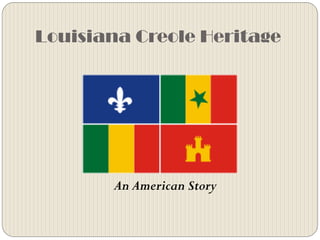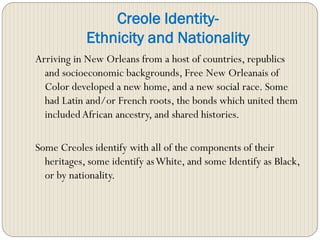Louisiana Creole Heritage Presentation
- 1. Louisiana Creole Heritage An American Story
- 2. An Academy of Lifelong Learning Presentation Proudly Submitted By Autumn Raynor Lone Star College CyFair
- 3. An Education ’éŚ Geography ’éŚ History ’éŚ Politics ’éŚ Communication ’éŚ Sociology ’éŚ
- 4. First Impressions Roll Call: Creole Connections Why this story now? Neighbors and Friends CommerCial Culture
- 5. Once upon a time in America . . .
- 7. Location, location, location! ’éŚ This city sits on the banks of the Mississippi River, south of Lake Pontchartrain, approximately 105 miles (169 km) upriver from the Gulf of Mexico. According to the United States Census Bureau, the city has a total area of 350.2 square miles (907 km2), of which 180.56 square miles (467.6 km2), or 51.55%, is land. ’éŚ The climate is humid subtropical- prime for cultivating crops and its port location prime for importing and exporting.
- 8. Dark Origins Contemporary historians estimate that between 9.4 and 12 million Africans were brought to ŌĆśThe New WorldŌĆÖ during the Atlantic Slave trade between the 16th and 19th centuries. Two-thirds of the more than one million slaves brought to the South arrived via the forced migration of the internal slave trade. As a principal port, New Orleans maintained the largest slave market in America.
- 9. New Orleans Historical Timeline ’éŚ Founded May 7, 1718, by ’éŚ Napoleon sold the the French on Chitimacha territory to the United land. States in the Louisiana ’éŚ Ceded to the Spanish Purchase in 1803. Empire in the Treaty of ’éŚ The Haitian Revolution of Paris in1763. 1804 increases the ’éŚ Remained under Spanish population by 9,000. control until 1801, when it ’éŚ American Civil War begins reverted to French control. in 1861.
- 10. Who lives here? And what are they doing?
- 11. News Orleans Society, 1800-1900 French, Spanish, and English-European Colonists are developing a multiethnic, multicultural society. French is the dominant language, architecture is primarily Spanish, English settlers map out industrial considerations. The great majority of residents, regardless of ethnicity and nationality are Roman Catholic.
- 12. News Orleans Society, 1800-1900 ’éŚ In this period, French, Spanish, and European Colonists held government positions owned businesses and worked on farms and A third tier emerges: in the port. ’éŚ Slaves were property, devoid of basic human rights.
- 13. Free People of Color
- 14. Free People of Color, Contemporary Creoles A definition of Cr├®ole from the earliest history in New Orleans (circa 1718) is ŌĆśa child born in the colony as opposed to France or SpainŌĆÖ. No ethnic delineation was provided. By the1800s, New Orleans residents of African descent were not all enslaved, but many had been liberated, born free in New Orleans, or migrated there as free men and women. Enslaved people of color who were native-born also began to be referred to as Creole, to distinguish them from new arrivals from Africa. Around 1810, the term Creole referred to a free persona of color.
- 15. Creole Identity- Ethnicity and Nationality Arriving in New Orleans from a host of countries, republics and socioeconomic backgrounds, Free New Orleanais of Color developed a new home, and a new social race. Some had Latin and/or French roots, the bonds which united them included African ancestry, and shared histories. Some Creoles identify with all of the components of their heritages, some identify as White, and some Identify as Black, or by nationality.
- 16. What does a Creole Person Look Like?
- 18. Like this . . .
- 19. This . . .
- 20. . . . This . . .
- 21. And this. ThatŌĆÖs water of course ’üŖ
- 22. Creole Identity- Language & Religion French, Spanish, and English were spoken through New Orleans and the Creole Diaspora. The term Creole is also used to describe a hybrid dialect of languages in linguistic studies. In this case, Creole language refers to the m├®lange of borrowed words and pronunciations from several influences. Roman Catholicism was the common religion of the area, as Spain and France were both devout nations at time of colonization.
- 23. Venerable Henriette DeLille Henriette DeLille (1813ŌĆō1862) founded the Catholic order of the Sisters of the Holy Family made up of free women of color, in New Orleans. In 1989 the order formally opened its cause with the Vatican in the canonization of Henriette DeLille. She was declared venerable in 2010.
- 24. Creole Identity- Social Justice Creole people were not regulated by the same laws other persons of African descent were. This included, curfews, property ownership, court remediation, marriage and birth rights, and social issues.
- 25. So now that youŌĆÖre Creole, what do you do all day? You should go to church You should eat something wonderful You should listen and dance to jazz, zydeco, and swing music You should pay attention to your family You should know not all things are black and white
- 26. Fast Forward >>>>>> Creole Heritage in the Millennial Context
- 27. Reaffirmation of Creole Roots The civil rights movement required all hands on deck for the advancement of African American equality. African American co-cultures merged for solidarity. Census results, current events, and global perspectives highlight the emergence of multiracial American identities. New Orleans has been in the national spotlight since 2005.
- 28. The Creole Heritage Flag The upper left section, a white fleur de lis on a blue field, represents Louisiana's French heritage. On the lower left and upper right sections, West African heritage is represented by the Mali Republic National tri-color flag (green, yellow and red) and the Senegal Republic National flag (green, yellow and red). Spanish Colonial heritage is depicted by the Tower of Castille (gold tower on a red field) on the lower right section. A white cross dividing the four symbols represents the Christian faith accepted by the Muslim and Islamic from Senegal and Mali in Louisiana.
- 29. Creoles You Should Know ’éŚ P.B.S. Pinchback, first non-white governor of an American State. ’éŚ Bryant and Greg Gumble, broadcast news personalities ’éŚ Suzanne Malveaux, journalist ’éŚ Dorothy Dandridge, actress ’éŚ Beyonce Knowles, pop singer ’éŚ Marc Morial, former mayor of New Orleans ’éŚ Jelly Roll Morton, blues singer
- 30. Creoles I Know
- 36. Thank you so much! Visit The Creole Heritage Society, or take the African American Heritage Tour in New Orleans for more information on all things Creole. http://creole.nsula.edu/




































